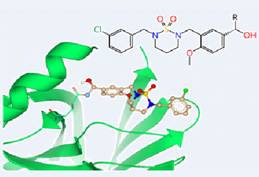Academic Journal of Chemistry
Online ISSN: 2519-7045
Print ISSN: 2521-0211
Print ISSN: 2521-0211
Quarterly Published (4 Issues Per Year)

Archives
Volume 7 Number 2 June 2022
γ-Zirconium Titanium-Phosphates – Fibrous Cerium Phosphate / Polyaniline, Polyindole, Polycarbazole and Polyimidazole Nanocomposite Membranes
Authors: S. K. Shakshooki ; F. A. El-Akari ; Suheila E. Kara ; M. K. Ellafi
Pages: 30-41
DOI: doi.org/10.32861/ajc.72.30.41
Abstract
Layered nanosized mixed γ-zirconium titanium phosphates and fibrous
cerium phosphate, γ-ZrxTi(1-x)..PO4.H2PO4.2H2O
(γ-ZTP), Ce(HPO4)2.2.9H2O(nCePf),
respectively, (x= 0.95, 0.89), and
their [γ-ZrxTi(1-x).PO4. H2PO4]0.3
[Ce(HPO4)2]0.70. 2H2O nanocomposite
membranes were prepared and characterized by chemical, x-ray diffraction (XRD),
thermogravimetric analysis (TGA) and Fourier transform spectroscopy (FT-IR). Novel
[γ-ZrxTi(1-x).PO4.H2PO4]0.3[Ce(HPO4)2]0.70
/polyaniline, polyindole,
polycarbazole, and polyimidazole nanocomposite membranes were
prepared via in-situ chemical oxidation of the monomers aniline, indole,
carbazole and imidazole, respectively, that was promoted by the reduction of Ce(IV)
ions present on the surface of the inorganic matrix composite. A possible
explanation is nCePf occurs at the surface of the composite was
attacked by the monomers, respectively, converted to cerium (III)
orthophosphate (CePO4). The resultant novel composites were
characterized by elemental (C,H,N) analysis and
FT-IR. From elemental (C,H,N) analysis the % in weight of the resultant conducting
polymers present in [γ-Zr0.95Ti0.05.PO4.H2PO4]0.3
[Ce(HPO4)2]0.70 composite were [ Pani
19.35, PIn 5,72. PCz 5.8, PIm 23.7]%. The % in weight of the conducting polymers in
the composite [γ-Zr0.9Ti0.11.PO4.H2PO4]0.3[[Ce(HPO4)2]0.70 were
[Pani 8.54, PIn 8.02, PCz 7.72,
PIm 22.27]%. The conductivity of the resultant conducting polymers found to be
in the range of semiconductors.
Interaction between Cadmium Oxide (CdO) Nanoparticles Aggregation Linked to DNA/RNA and Aryl Mercaptanes With Various Chain Length
Authors: Alireza Heidari
Pages: 23-29
DOI: doi.org/10.32861/ajc.72.23.29
Abstract
CdO nanoparticles show a strong peak of Plasmon absorption in ultraviolet–visible zone. A strong interaction exists between the surface of CdO nanoparticles and aryl mercaptan compounds. Aryl mercaptan compounds cause aggregation of CdO nanoparticles linked to DNA/RNA and hence, lead to widening of peak Plasmon of CdO nanoparticles surface at 550 (nm) and emerging a new peak at a higher wavelength. In the current project, this optical characteristic of CdO nanoparticles is used to time investigate of interaction between different aryl mercaptanes and CdO nanoparticles. The results were shown that aryl mercaptan compounds with shorter chain length interact faster with CdO nanoparticles. Therefore, a simple and fast method for identification of aryl mercaptanes with various chain length using red shift in surficial Plasmon absorption is presented.

Schematic of Cadmium Oxide (CdO) Nanoparticles Aggregation Linked to DNA/RNA by Aryl Mercaptanes with Various Chain Length.
Enzymatic Biocatalysis of Biomass from Aquatic Plant Phragmite Karka for Second-Generation Bioethanol Production
Authors: Cosme Sagbo Kouwanou ; Euloge Sènan Adjou ; Cokou Pascal Agbangnan Dossa ; Dominique Codjo Koko Sohounhloué
Pages: 17-22
DOI: doi.org/10.32861/ajc.72.17.22
Abstract
In the context of energy transition and the reduction of greenhouse gas emissions, the production of second-generation bioethanol is also recognized as a promising way to reduce our dependence on fossil fuels. Then, the present studies aim to evaluate the enzymatic biocatalysis of biomass from aquatic plant Phragmite karka in the second-generation bioethanol production. Results obtained revealed a rapid decrease of °Brix during the fermentation of musts and underlined the efficacy of enzyme hydrolysis. The rate of sugar consumption by yeasts is between 32.43 and 70.27%. The yield of ethanol production of yeasts indicated that Angel Brand Thermal-tolerant alcohol active dry yeast was the best yeast strain for this fermentation. These findings underline the potential of Phragmite karka plant materials in the perspective of intensive production of second-generation bioethanol.



